Do SEO best practices for 2024 differ from 2023?
Short answer: Yes.
Search engines have changed a lot in 2023. Advances in AI and machine learning help search engine algorithms better understand search queries. Search generative experience has transformed how search engines serve their users.
This calls for changes in SEO techniques to continue growing your business and traffic organically.
Follow these SEO best practices to improve search ranking in 2024 and beyond:
1. First-Hand Experience is the Key
Google updated E-A-T guidelines in 2022 by adding another E to it that indicates ‘Experience’. This is a key differentiator as experience is something that you can’t get with AI-generated content (which is now becoming very common).
Here’s what Google says about experience-driven content:

If you don’t have first-hand or real-life experience of doing something, you are least likely to rank for such type of content. Real experience is crucial for two main reasons:
- It helps differentiate AI content from helpful content. AI-generated content can’t have experience so it’s an easy way to appreciate original content
- It helps Google identify fake reviews and reward real reviewers who buy and use a product before sharing its review.
Here’s an example of content that demonstrates first-hand experience:
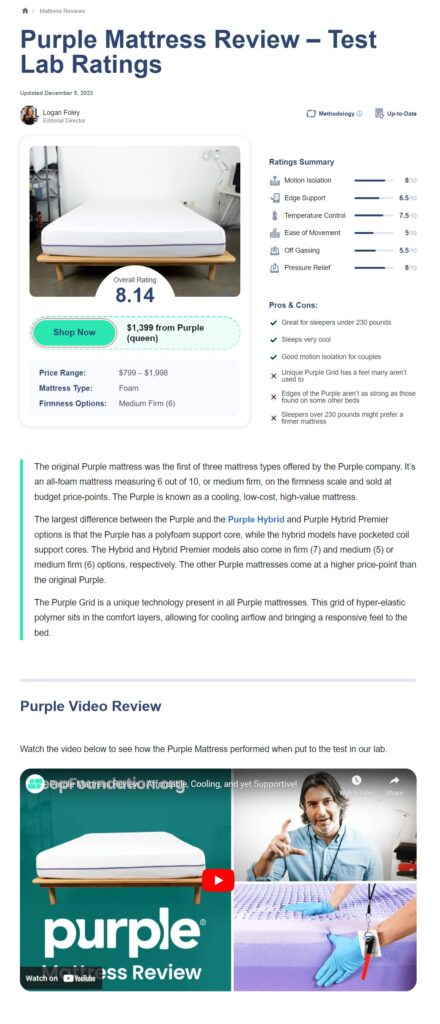
They purchased and tested the review in different ways including motion isolation, pressure relief, temperature control, edge support, ease of movement, and off-gassing. This is all supported by real images of devices that were used in the testing and review process.
This type of content deserves to get rewarded because the authors have done a great job.
The big question is: How can you demonstrate real-life experience for content that you generate?
Here’s how you can do it:
- Write on topics that you have experience in. This means you should write what you do. That’s the simplest way to improve SEO. If you have a chicken farm, write on chicken farming because that’s how you can generate real images and videos
- Interview an expert and refer to it in your content. In this case, most of the content should be based on the expert’s views – instead of yours. This is ideal in situations where you don’t have experience but still want to cover a topic
- Conduct primary research on a topic and present it in your article. It’s best if you collect qualitative data through interviews, focus groups, behavior analysis, and other techniques. Sharing data analysis and your insights helps you demonstrate life experience
- You can curate and list other people’s experiences in your content. This works best when you don’t have first-hand experience with a topic you are covering. Reddit and Quora, for example, don’t have their own experience rather they rely on UGC content to rank for pretty much anything you can think of.
Generic content that anyone can write with little or no effort won’t rank. It is useless to waste your resources on mediocre content. The type of content that’ll rule SERPs would be purely experience-based. The best example you can get is from travel vloggers on YouTube. They visit a place and then cover its ins and outs. This is the reason they usually have thousands of views. Not just Google and YouTube love their content, people love it even more.
If you want to rule SERPs in 2024 and beyond, create this type of content.
2. Improve Topical Authority
When you consistently write about a specific topic, your website becomes a credible source of information on that subject in the eyes of search engines. This is known as topical authority and it plays a crucial role in SEO.
Here’s how:
- Topical authority helps you demonstrate E-E-A-T especially expertise on a specific topic.
- Search engines use semantic search that’s more focused on search intent and context (more on this later) of the search query. This makes websites that cover a certain topic in detail more relevant for keywords that belong to the topic.
- It helps you build trust and become a credible source of information on a specific topic. You become a thought leader in your industry when you cover a topic completely.
- Topical authority improves internal linking as you have a lot of relevant pages that you can interlink easily.
- It helps you acquire backlinks naturally as you become a credible source of information on a specific topic.
Google also uses topic authority to understand what experts are saying about a specific topic:

Google uses 3 key indicators to identify expertise to demonstrate topical authority:
- Search query relevance to the topic. If most people visit a certain website for a specific topic, Google considers the source expert on that topic
- Original reporting or research on a topic that’s cited by other sites
- Reputation of the site as to how often it creates high-quality content on a topic and how often it has been cited or referenced by other experts.
These guidelines make it easy to develop topical authority and improve your site’s ranking. Here are the best practices to improve your topical authority and significantly improve ranking and organic traffic:
- Identify topic clusters for your site and develop a pillar page strategy (see image below). It requires you to create pillar and cluster pages around the same broad topic and interlink them strategically
- Create quality content. Focus on generating original research-based content such as case studies and whitepapers. Primary data collection through surveys and interviews works best for generating authoritative content around topic clusters
- Internal link cluster pages to pillar pages and vice versa. This helps search engines find relevant content on that topic easily and it strengthens topical authority
- Acquire backlinks as they are most important for improving topical authority. Backlinks are considered a vote of confidence by other publishers and it helps you establish your content as authoritative fairly quickly.

3. Optimize for Search Intent
Search intent or keyword intent refers to the motive of a searcher. Google and other search engines now look at the intent behind a search query and the results are based on the intent.
For example, if you search for “team collaboration tool”, you get lists of the best tools and apps published by different blogs. You don’t get any specific team collab app.
Why?
Because Google knows (from data and user behavior) that people who search for team collaboration tools are looking for a list of apps, not a specific app to purchase. The intent in this case is to get information as opposed to transactional intent.

You need to optimize content and web pages based on intent – not keywords. The best way to understand the intent of a keyword is by analyzing top ranking pages. The type of content already ranking indicates the intent as to what a searcher is looking for.
There are 4 types of keyword intent that you’ll generally find in SERPs:
- Informational intent is where the searcher is looking for information and specific answers to the query
- Navigational intent is used when the searcher is looking for a specific website
- Commercial intent is where the user is doing research before finalizing a purchase
- Transactional intent is when a user is ready to make a purchase.

The search intent should be aligned with your sales funnel. Informational and navigational intent is suitable for the top of the funnel, commercial for mid-funnel, and transactional searches are done at the bottom of the funnel:

Understanding and uncovering search intent for keywords and topics, and then embedding it in your sales funnel will improve search rankings and UX.
4. Improve Core Web Vitals
Core web vitals are metrics used to track UX on a webpage. These metrics are known Google ranking factors and the transition is expected to be completed in 2024 as reported by Google:

Core web vitals include 3 metrics that you need to work on for better UX and SEO in 2024:
- Largest Contentful Paint (LCP): It measures page loading performance by tracking how quickly the main content of the page loads. The benchmark LCP is 2.5 seconds.
- Interaction to Next Paint (INP): It measures responsiveness in terms of user action. It tracks the time taken when a user performs an action on your site to when the browser responds. The benchmark for INP is 200 ms.
- Cumulative Layout Shift (CLS): It tracks visual stability by analyzing layout shifts. Any changes in the position of any element on your webpage is known as a layout shift. The benchmark for CLS is 0.1.
Simply put, your website should load fast without any errors and deliver exceptional UX. You can track core web vitals in Google Search Console for sites you own:

You can use PageSpeed Insights to track the core web vitals of any site. The good thing about PageSpeed Insights is that it gives you recommendations on how to improve metrics UX by fixing issues:
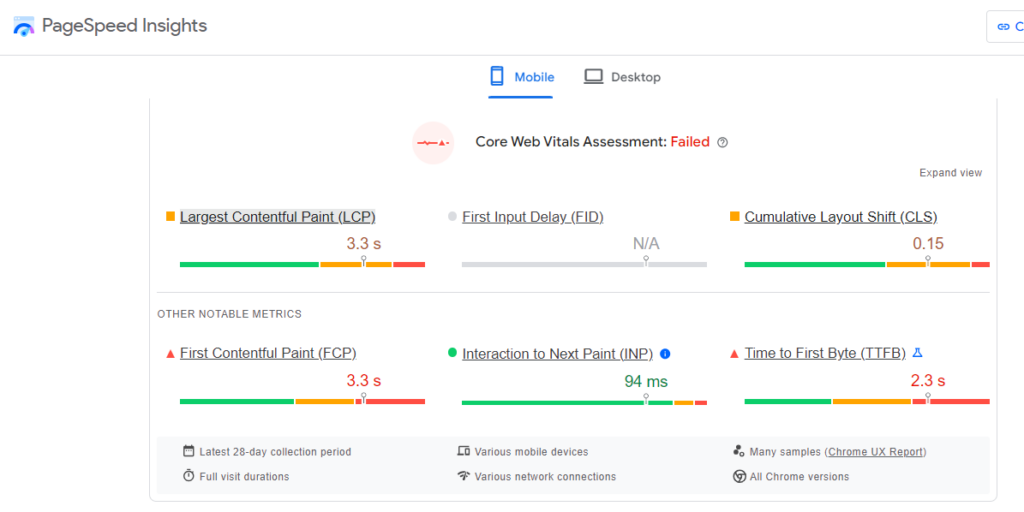
Here’s a checklist to improve the core web vitals of your site to improve rankings and avoid UX issues:
- Visit PageSpeed Insights and enter your site’s URL. Analyze the report and follow recommendations. This is the best you can do for your site’s SEO and speed optimization
- Remove third-party unwanted scripts. You can find problematic scripts in the PageSpeed Insights report
- Minimize JavaScript to improve INP
- Use browser caching to improve page load speed. Use a plugin for browser caching
- Compress images and use webp format to serve images on your site. Avoid large images with high-resolution
- Enable lazy loading for images
- Set dimensions and attributes for the media you are using such as images to avoid unnecessary layout shifts
- Avoid adding content atop existing content such as text over an image. This leads to layout shifts that ruin the UX
- Use a content delivery network (CDN) as it solves most speed and performance-related issues that will lead to improved core web vitals
- Minify CSS and JavaScript to reduce LCP.
5. Optimize Content for Search Generative Experience
SGE or search generative experience will have a huge impact on SEO, organic traffic, and rankings in 2024 and beyond. You should prepare for it to keep getting organic traffic.
Google uses generative AI in search (you might have already seen it) and Bing is also using it. You might argue that search engines are stealing your traffic using your content, but it won’t change anything. The rule of the (SEO) game changed, you have to improvise.
The good thing is that both Google and Bing add references in AI content. Here’s an example:
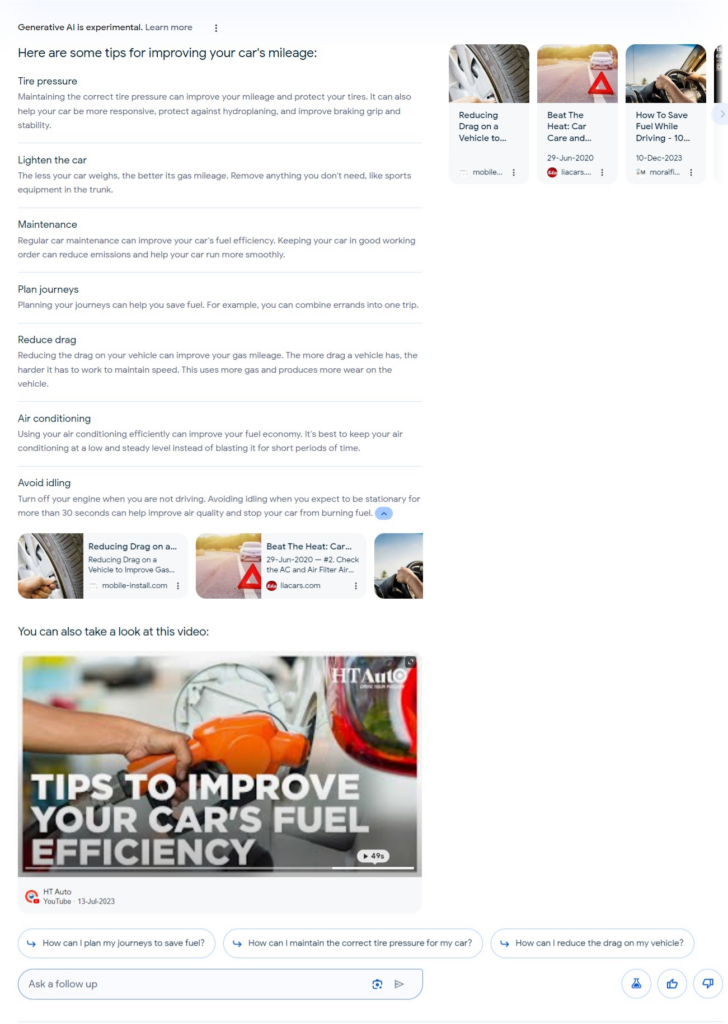
The content cites top resources with links and images along with a relevant YouTube video. All the sources are clickable which means users can click and visit a relevant site or watch a video.
You need to optimize your content for SGE so that your content is cited. The only way to outrank organic results, that are buried down the SERPs now, is to have your site up in the SGE. That’s one way to drive organic traffic right from SGE to your site.
In most cases, the SGE answer box uses content from top-ranking organic results to generate the answer and it cites organic results on the first page. This means you have to follow the same basic principles of SEO to get cited by SGE.
You have to go a step ahead of your competitors by making it easier for SGE to read and understand your content. Here’s how to optimize content for SGE to drive organic clicks by getting referenced:
- Analyze SGE results for a target keyword. Understand search intent and the answer AI has generated
- Analyze cited sources. This will give you an idea of what type of sites these are, what type of content they have, and how to write better content
- Create content that’s better than all the cited sources for the target query. This means you have to add more depth or a unique angle to the content
- Add your unique data, point of view, observation, or even criticism to the article
- Add images and videos as SGE adds media as well
- Use direct, concise, and simple language. Avoid fluff
- Start every heading and subheading with a summary of what it covers. This should be 1-2 sentences and to the point. That’s more likely to be picked up by SGE.
6. Refresh Old Content
One of the easiest SEO techniques that require minimal resources is refreshing existing content. It is easier and quicker than creating new content.
A survey revealed that 53% of marketers reported an increase in engagement and 49% reported an increase in organic traffic after updating content:
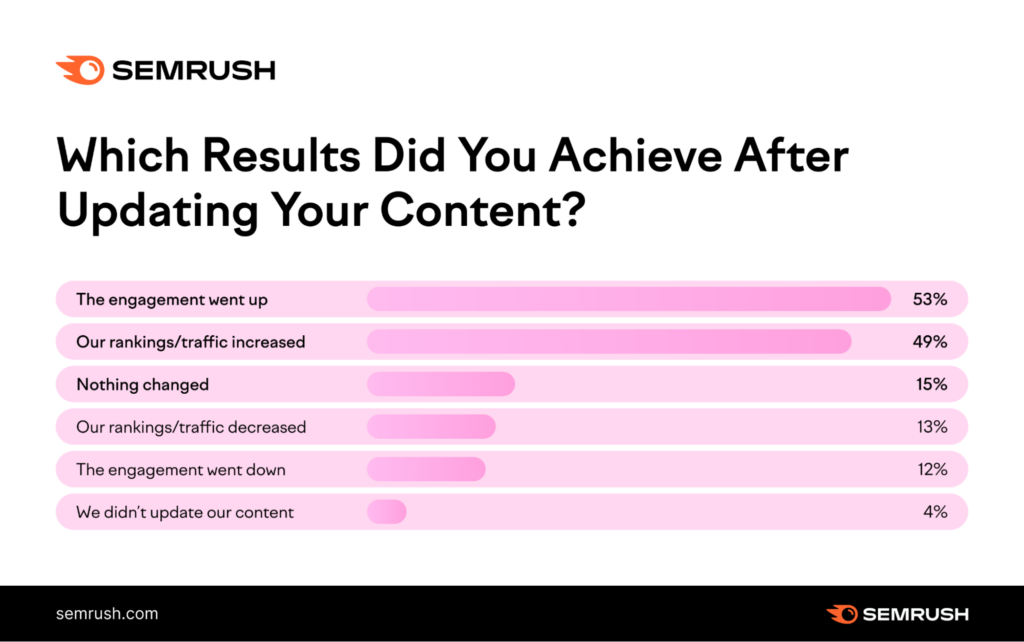
Search engines prefer ranking fresh content in SERPs as this is what users expect. If you are searching for something, you are least likely to visit a page that was published in 2019 or 2018. Most people use the current year in their search term to find updated and fresh information.
As soon as 2024 started, global interest in 2024 increased significantly while interest in 2023 declined. The interest in 2024 started increasing from October 2023 and corresponding interest in the 2023 search term started declining gradually:
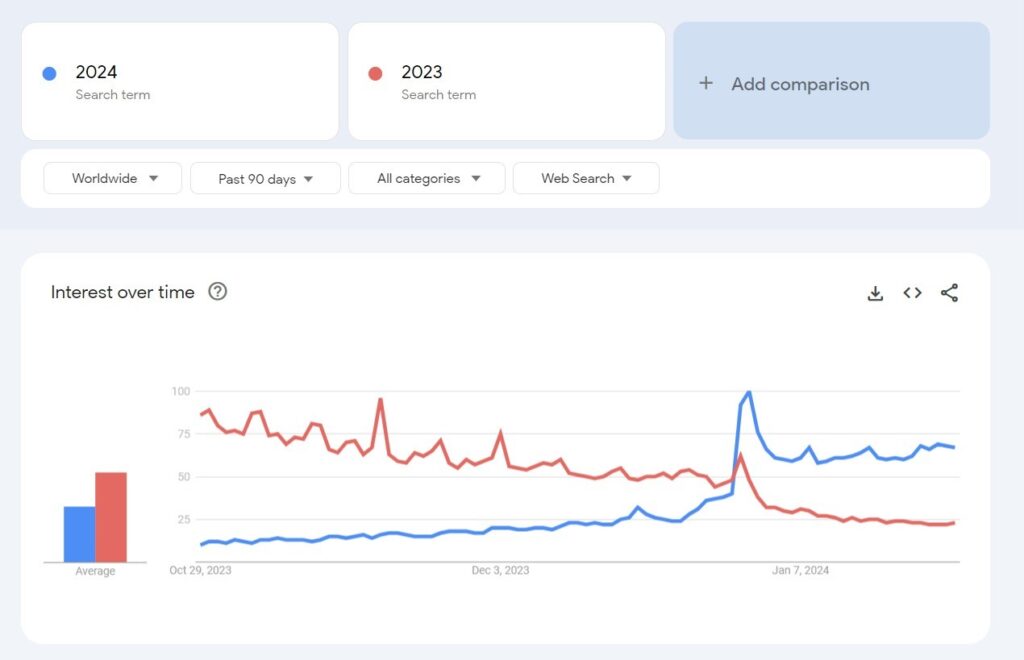
This is a reason why you see the most recent pages up in the SERPs because Google knows what its users prefer. Even if you don’t mention 2024 in a search query, most of the top pages will be the most recent ones. Here’s an example:

Single Grain increased its blog traffic by 96% after updating and refreshing 42 blog posts. The traffic jumped from 9,207 visitors to 18,030 visitors per month in 6 months.
You need to identify the right content for updates and this is the tricky part. Most businesses and marketers avoid refreshing existing content as it often leads to a reduction in organic traffic post-refresh.
Since search engines prefer serving new and updated content to their users, you have to take the risk. Old content will eventually lose ranking anyway.
The most crucial step is identifying articles for updates. Ideally, you should go for pages that rank on the first page but don’t rank in the top 3 results. Target pages that rank between 4-10 which indicates their potential to rank.
It is best to use heatmap, session recordings, and scroll maps to analyze these pages before making content tweaks. The analysis will help you identify elements and sections with the highest and lowest engagements.
The rule is to not touch content sections that have the highest engagement unless it is necessary such as fixing a factual error or updating an old stat.
You should update content sections with the lowest engagement where user activity is minimal. You can refresh content in multiple ways:
- Remove unnecessary content that’s irrelevant and has low user activity
- Add more content or revise existing content to make it relevant and updated
- Update statistics and facts
- Add media in areas of low engagement such as a chart or graph
- Restructure content based on search intent. Analyze top search results to understand keyword intent and see where your content lacks
- Re-optimize content by adding/replacing keywords and subheadings.
7. Build Backlinks
Backlinks are the most powerful ranking factor and are crucial for SEO success. Multiple studies revealed that more backlinks from unique domains lead to higher ranking and authority.
This is because backlinks are the only way to determine the popularity of a webpage. There isn’t any other better way to determine the popularity of a website. Backlinks aren’t going anywhere in 2024 and beyond.
Here are the best ways to acquire backlinks in 2024 to improve your site’s SEO:
1. Create linkable assets
Having assets that persuade others to link to them and cite them works best. Linkable assets are created to acquire backlinks. Since these assets are high-quality content pieces that are hard to find elsewhere, people link to them without hesitation.
A typical example of a linkable asset is original research shared in the form of a whitepaper, PDF, or blog post. Here’s an example:

The blog post is based on an analysis of 14 billion pages which makes it link-worthy. It shares the findings of the study in the form of charts and graphs. These types of studies aren’t published too often because they require resources.
But it pays off.
The article has 3.33K linking websites:

3.33K linking websites, not bad…
You can’t get links from over 3K unique websites with ordinary content. You have to create something amazing, rare, and inimitable to acquire backlinks.
Here are a few leading types of linkable assets that you should consider creating in 2024:
- Interactive content such as interactive infographics
- Original research studies where you collect and analyze primary or secondary data
- Tools and calculators that are available for free such as the BMI calculator
- In-depth guides that share first-hand experience with the readers
- Coin a term in your niche such as skyscraper technique was coined by Brian Dean.
2. Reach out to fellow bloggers
Creating linkable assets isn’t enough. You have to reach out to relevant sites, authors, influencers, and webmasters and show them your content. Without a rigorous outreach campaign, your linkable asset will keep sitting on your blog without getting any attention.
Most SEO experts assume that publishing a linkable asset and sharing it on social platforms is enough. When they see no traction, they believe they didn’t create the best piece.
That’s not the case.
You have to reach out to the right people and show them what you have created so they can link to it. You need to put your content in front of the right eyeballs.
Even if you don’t get a backlink or a reply, you’ll build your network which will help you get backlinks for any type of content even if it’s not link-worthy. That’s how big fish promote their content and consistently stay in the top rankings. They have a network of like-minded people and they have established themselves as a credible source of information.
Here’s an example of an outreach template:
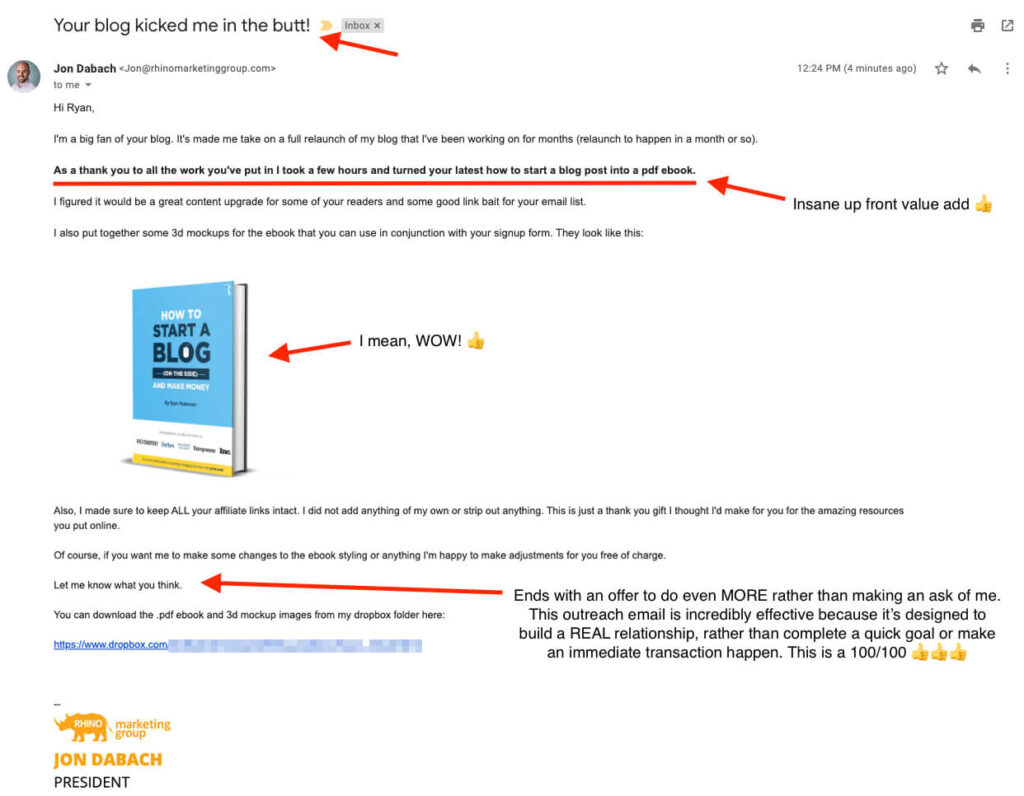
Follow these steps to run an outreach campaign for backlink acquisition:
- Create amazing, linkable content
- Prepare a list of sites that have linked to similar content. Use a keyword research tool to do this
- Reach out to them with a link to your content. Clearly indicate what’s in it for them and why they should consider linking to your content
- Repeat.
Don’t let low response rates demotivate you. Keep doing it consistently as it helps you grow your network and make new connections in the process.
3. HARO
Help a Reporter Out (HARO) is a free platform that makes it easy to get backlinks from high authority sites. Journalists use it to send out requests using HARO and you receive a digest with top requests based on your interest.
You need to send customized pitches to journalists and bloggers.
When your pitch is accepted, you’ll get exposure, a backlink, and a mention at a high DA site. This works exceptionally well when you are consistent.
The acceptance rate is low due to high competition, but even if you get one link per 100 pitches, it’s not a bad deal. It hardly takes 30 minutes to read requests daily and respond to the most relevant ones.
Give it a try and see how it goes for you.
Conclusion
SEO isn’t expected to change a lot in 2024. You need to stick with the basics of SEO and keep following the best practices discussed in this article.
Keep an eye on the algorithm changes and prepare yourself ahead of time. For example, INP is expected to fully replace FID in March 2024, it is currently a pending core web vital metric. This means you have enough time to tweak your site and make it INP-compliant.
You need to stay updated on the SEO news and tweak your SEO strategy accordingly. The fact is that changes in the SEO industry are far too rapid. Something keeps happening regularly. Businesses, marketers, and SEOs who follow a proactive approach outperform their competitors.
Featured Image: Pexels



